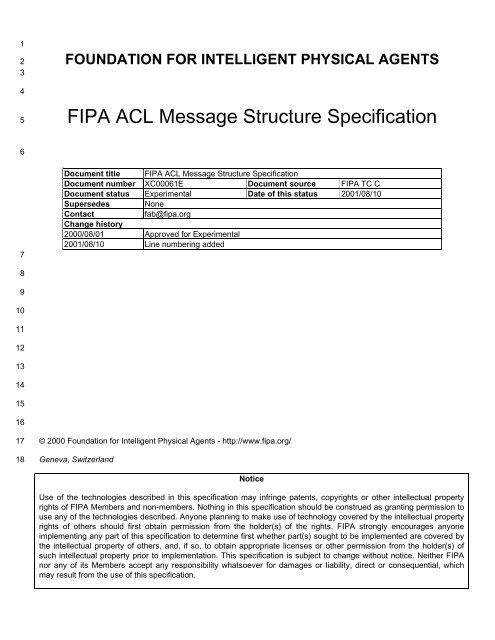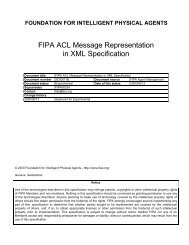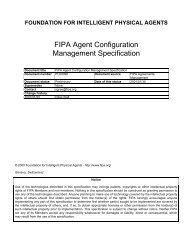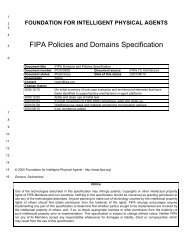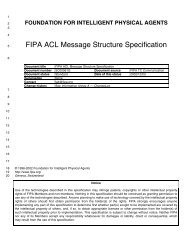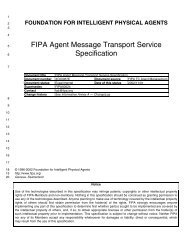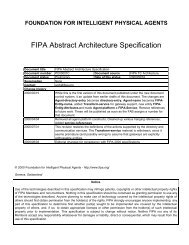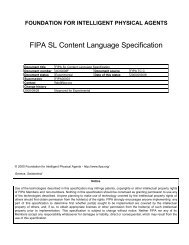FIPA ACL Message Structure Specification
FIPA ACL Message Structure Specification
FIPA ACL Message Structure Specification
Create successful ePaper yourself
Turn your PDF publications into a flip-book with our unique Google optimized e-Paper software.
1<br />
2<br />
3<br />
4<br />
5<br />
FOUNDATION FOR INTELLIGENT PHYSICAL AGENTS<br />
<strong>FIPA</strong> <strong>ACL</strong> <strong>Message</strong> <strong>Structure</strong> <strong>Specification</strong><br />
6<br />
7<br />
Document title <strong>FIPA</strong> <strong>ACL</strong> <strong>Message</strong> <strong>Structure</strong> <strong>Specification</strong><br />
Document number XC00061E Document source <strong>FIPA</strong> TC C<br />
Document status Experimental Date of this status 2001/08/10<br />
Supersedes None<br />
Contact<br />
fab@fipa.org<br />
Change history<br />
2000/08/01 Approved for Experimental<br />
2001/08/10 Line numbering added<br />
8<br />
9<br />
10<br />
11<br />
12<br />
13<br />
14<br />
15<br />
16<br />
17<br />
18<br />
© 2000 Foundation for Intelligent Physical Agents - http://www.fipa.org/<br />
Geneva, Switzerland<br />
Notice<br />
Use of the technologies described in this specification may infringe patents, copyrights or other intellectual property<br />
rights of <strong>FIPA</strong> Members and non-members. Nothing in this specification should be construed as granting permission to<br />
use any of the technologies described. Anyone planning to make use of technology covered by the intellectual property<br />
rights of others should first obtain permission from the holder(s) of the rights. <strong>FIPA</strong> strongly encourages anyone<br />
implementing any part of this specification to determine first whether part(s) sought to be implemented are covered by<br />
the intellectual property of others, and, if so, to obtain appropriate licenses or other permission from the holder(s) of<br />
such intellectual property prior to implementation. This specification is subject to change without notice. Neither <strong>FIPA</strong><br />
nor any of its Members accept any responsibility whatsoever for damages or liability, direct or consequential, which<br />
may result from the use of this specification.
19<br />
20<br />
21<br />
22<br />
23<br />
24<br />
25<br />
26<br />
27<br />
28<br />
29<br />
30<br />
31<br />
32<br />
33<br />
34<br />
35<br />
36<br />
37<br />
Foreword<br />
The Foundation for Intelligent Physical Agents (<strong>FIPA</strong>) is an international organization that is dedicated to promoting the<br />
industry of intelligent agents by openly developing specifications supporting interoperability among agents and agentbased<br />
applications. This occurs through open collaboration among its member organizations, which are companies and<br />
universities that are active in the field of agents. <strong>FIPA</strong> makes the results of its activities available to all interested parties<br />
and intends to contribute its results to the appropriate formal standards bodies.<br />
The members of <strong>FIPA</strong> are individually and collectively committed to open competition in the development of agentbased<br />
applications, services and equipment. Membership in <strong>FIPA</strong> is open to any corporation and individual firm,<br />
partnership, governmental body or international organization without restriction. In particular, members are not bound to<br />
implement or use specific agent-based standards, recommendations and <strong>FIPA</strong> specifications by virtue of their<br />
participation in <strong>FIPA</strong>.<br />
The <strong>FIPA</strong> specifications are developed through direct involvement of the <strong>FIPA</strong> membership. The status of a<br />
specification can be either Preliminary, Experimental, Standard, Deprecated or Obsolete. More detail about the process<br />
of specification may be found in the <strong>FIPA</strong> Procedures for Technical Work. A complete overview of the <strong>FIPA</strong><br />
specifications and their current status may be found in the <strong>FIPA</strong> List of <strong>Specification</strong>s. A list of terms and abbreviations<br />
used in the <strong>FIPA</strong> specifications may be found in the <strong>FIPA</strong> Glossary.<br />
<strong>FIPA</strong> is a non-profit association registered in Geneva, Switzerland. As of January 2000, the 56 members of <strong>FIPA</strong><br />
represented 17 countries worldwide. Further information about <strong>FIPA</strong> as an organization, membership information, <strong>FIPA</strong><br />
specifications and upcoming meetings may be found at http://www.fipa.org/.<br />
ii
38<br />
39<br />
40<br />
41<br />
42<br />
43<br />
44<br />
45<br />
46<br />
47<br />
48<br />
49<br />
50<br />
51<br />
52<br />
53<br />
54<br />
55<br />
56<br />
57<br />
58<br />
59<br />
60<br />
61<br />
62<br />
63<br />
Contents<br />
1 Scope.......................................................................................................................................................................... 1<br />
2 <strong>FIPA</strong> <strong>ACL</strong> <strong>Message</strong> <strong>Structure</strong>..................................................................................................................................... 2<br />
2.1 Type of Communicative Act................................................................................................................................. 3<br />
2.1.1 Performative ................................................................................................................................................. 3<br />
2.2 Participants in Communication ............................................................................................................................ 3<br />
2.2.1 Sender .......................................................................................................................................................... 3<br />
2.2.2 Receiver ....................................................................................................................................................... 3<br />
2.2.3 Reply To ....................................................................................................................................................... 4<br />
2.3 Content of <strong>Message</strong>............................................................................................................................................. 4<br />
2.3.1 Content ......................................................................................................................................................... 4<br />
2.4 Description of Content ......................................................................................................................................... 4<br />
2.4.1 Language...................................................................................................................................................... 4<br />
2.4.2<br />
2.4.3<br />
Encoding....................................................................................................................................................... 4<br />
Ontology ....................................................................................................................................................... 4<br />
2.5 Control of Conversation ....................................................................................................................................... 5<br />
2.5.1 Protocol ........................................................................................................................................................ 5<br />
2.5.2<br />
2.5.3<br />
Conversation Identifier.................................................................................................................................. 5<br />
Reply With .................................................................................................................................................... 5<br />
2.5.4<br />
2.5.5<br />
In Reply To ................................................................................................................................................... 5<br />
Reply By ....................................................................................................................................................... 5<br />
3 Maintenance of the <strong>FIPA</strong> <strong>ACL</strong> <strong>Message</strong> Elements List .............................................................................................. 7<br />
3.1.1<br />
3.1.2<br />
Inclusion Criteria........................................................................................................................................... 7<br />
Comments and Questions ............................................................................................................................ 7<br />
4 References.................................................................................................................................................................. 8<br />
iii
63<br />
64<br />
65<br />
66<br />
67<br />
68<br />
69<br />
70<br />
71<br />
72<br />
1 Scope<br />
This document contains specifications for the <strong>FIPA</strong> <strong>ACL</strong> message elements including: the list of current <strong>FIPA</strong> <strong>ACL</strong><br />
message elements, procedures for maintenance of this list, and criteria for adopting new elements in the list.<br />
The objectives of standardizing the form of a <strong>FIPA</strong> compliant <strong>ACL</strong> message are:<br />
To help ensure interoperability by providing a standard set of <strong>ACL</strong> message structure, and,<br />
To provide a well-defined process for maintaining this set.
© 2000 Foundation for Intelligent Physical Agents <strong>FIPA</strong> <strong>ACL</strong> <strong>Message</strong> <strong>Structure</strong><br />
72<br />
73<br />
74<br />
75<br />
76<br />
77<br />
78<br />
79<br />
80<br />
81<br />
82<br />
83<br />
84<br />
85<br />
86<br />
87<br />
88<br />
89<br />
90<br />
91<br />
92<br />
93<br />
94<br />
95<br />
96<br />
97<br />
98<br />
99<br />
100<br />
101<br />
102<br />
103<br />
104<br />
105<br />
2 <strong>FIPA</strong> <strong>ACL</strong> <strong>Message</strong> <strong>Structure</strong><br />
A <strong>FIPA</strong> <strong>ACL</strong> message contains a set of one or more message elements. Precisely which elements are needed for<br />
effective agent communication will vary according to the situation; the only element that is mandatory in all <strong>ACL</strong><br />
messages is the performative, although it is expected that most <strong>ACL</strong> messages will also contain sender,<br />
receiver and content elements.<br />
If an agent does not recognize or is unable to process one or more of the elements or element values, it can reply with<br />
the appropriate not-understood message.<br />
Specific implementations are free to include user-defined message elements other than the <strong>FIPA</strong> <strong>ACL</strong> message<br />
elements specified in Table 1. The semantics of these user-defined elements is not defined by <strong>FIPA</strong>, and <strong>FIPA</strong><br />
compliance does not require any particular interpretation of these elements.<br />
Some elements of the message might be omitted when their value can be deduced by the context of the conversation.<br />
However, <strong>FIPA</strong> does not specify any mechanism to handle such conditions, therefore those implementations that omit<br />
some message elements are not guaranteed to interoperate with each other.<br />
The full set of <strong>FIPA</strong> <strong>ACL</strong> message elements is shown in Table 1 without regard to their specific encodings in an<br />
implementation. <strong>FIPA</strong>-approved encodings and element orderings for <strong>ACL</strong> messages are given in other specifications.<br />
Each <strong>ACL</strong> message representation specification contains precise syntax descriptions for <strong>ACL</strong> message encodings<br />
based on XML, text strings and several other schemes.<br />
A <strong>FIPA</strong> <strong>ACL</strong> message corresponds to the abstract element message payload identified in the [<strong>FIPA</strong>00001].<br />
Element<br />
Category of Elements<br />
performative<br />
Type of communicative acts<br />
sender<br />
Participant in communication<br />
receiver<br />
Participant in communication<br />
reply-to<br />
Participant in communication<br />
content<br />
Content of message<br />
language<br />
Description of Content<br />
encoding<br />
Description of Content<br />
ontology<br />
Description of Content<br />
protocol<br />
Control of conversation<br />
conversation-id<br />
Control of conversation<br />
reply-with<br />
Control of conversation<br />
in-reply-to<br />
Control of conversation<br />
reply-by<br />
Control of conversation<br />
Table 1: <strong>FIPA</strong> <strong>ACL</strong> <strong>Message</strong> Elements<br />
The following terms are used to define the ontology and the abstract syntax of the <strong>FIPA</strong> <strong>ACL</strong> message structure:<br />
Frame. This is the mandatory name of this entity, that must be used to represent each instance of this class.<br />
Ontology. This is the name of the ontology, whose domain of discourse includes their elements described in the<br />
table.<br />
2
© 2000 Foundation for Intelligent Physical Agents <strong>FIPA</strong> <strong>ACL</strong> <strong>Message</strong> <strong>Structure</strong><br />
106<br />
107<br />
108<br />
109<br />
110<br />
111<br />
112<br />
113<br />
114<br />
115<br />
116<br />
117<br />
118<br />
119<br />
120<br />
121<br />
122<br />
123<br />
124<br />
125<br />
126<br />
127<br />
128<br />
129<br />
130<br />
131<br />
132<br />
133<br />
134<br />
135<br />
136<br />
137<br />
138<br />
139<br />
140<br />
141<br />
142<br />
143<br />
144<br />
Element. This identifies each component within the frame. The type of the element is defined relative to a<br />
particular encoding. Encoding specifications for <strong>ACL</strong> messages are given in their respective specifications.<br />
Description. This is a natural language description of the semantics of each element. Notes are included to clarify<br />
typical usage.<br />
Reserved Values. This is a list of <strong>FIPA</strong>-defined constants associated with each element. This list is typically<br />
defined in the specification referenced.<br />
All of the <strong>FIPA</strong> message elements share the frame and ontology shown in Table 2.<br />
Frame<br />
Ontology<br />
2.1 Type of Communicative Act<br />
<strong>FIPA</strong>-<strong>ACL</strong>-<strong>Message</strong><br />
<strong>FIPA</strong>-<strong>ACL</strong><br />
Table 2: <strong>FIPA</strong> <strong>ACL</strong> <strong>Message</strong> Frame and Ontology<br />
2.1.1 Performative<br />
Element Description Reserved Values<br />
performative Denotes the type of the communicative act of the <strong>ACL</strong> message See [<strong>FIPA</strong>00037]<br />
Notes: The performatives is a required element of all <strong>ACL</strong> messages. Developers are encouraged to use the <strong>FIPA</strong><br />
standard performatives (see [<strong>FIPA</strong>00037]) whenever possible.<br />
2.2 Participants in Communication<br />
2.2.1 Sender<br />
Element Description Reserved Values<br />
sender Denotes the identity of the sender of the message, i.e. the name<br />
of the agent of the communicative act.<br />
Notes: The sender element will be an element of most <strong>ACL</strong> messages. It is possible to omit the sender if, for example,<br />
the agent sending the <strong>ACL</strong> message wishes to remain anonymous. The sender refers to the agent which performs the<br />
communicative act giving rise to this <strong>ACL</strong> message.<br />
2.2.2 Receiver<br />
Element Description Reserved Values<br />
receiver Denotes the identity of the intended recipients of the message.<br />
Notes: Ordinarily, the receiver will be a part of every <strong>ACL</strong> message. It is only permissible to omit the receiver if the<br />
message recipient can be reliably inferred from context, or in special cases such as the embedded <strong>ACL</strong> message in<br />
proxy and propagate.<br />
The receiver may be a single agent name, or a non-empty set of agent names. The latter corresponds to the situation<br />
where the message is multicast. Pragmatically, the semantics of this multicast is that the sender intends the message<br />
for each recipient of the CA encoded in the message. For example, if an agent performs an inform act with a set of<br />
three agents as receiver, it denotes that the sender intends each of these agents to come to believe the content of the<br />
message.<br />
3
© 2000 Foundation for Intelligent Physical Agents <strong>FIPA</strong> <strong>ACL</strong> <strong>Message</strong> <strong>Structure</strong><br />
145<br />
146<br />
147<br />
148<br />
149<br />
150<br />
151<br />
152<br />
153<br />
154<br />
155<br />
156<br />
157<br />
158<br />
159<br />
160<br />
161<br />
162<br />
163<br />
164<br />
165<br />
166<br />
167<br />
168<br />
169<br />
170<br />
171<br />
2.2.3 Reply To<br />
Element Description Reserved Values<br />
reply-to This element indicates that subsequent messages in this<br />
conversation thread are to be directed to the agent named in the<br />
reply-to element, instead of to the agent named in the sender<br />
element.<br />
2.3 Content of <strong>Message</strong><br />
2.3.1 Content<br />
Element Description Reserved Values<br />
content Denotes the content of the message; equivalently denotes the<br />
object of the action.<br />
Notes: Most <strong>ACL</strong> messages require a content expression. Certain <strong>ACL</strong> message types, such as cancel, have an implicit<br />
content, especially in cases of using conversation-id or in-reply-to.<br />
2.4 Description of Content<br />
2.4.1 Language<br />
Element Description Reserved Values<br />
language Denotes the language in which the content element is expressed. See [<strong>FIPA</strong>00007]<br />
Notes: The <strong>ACL</strong> content element is expressed in a formal language. This field may be omitted if the agents receiving<br />
the message can be assumed to know the language of the content expression.<br />
2.4.2 Encoding<br />
Element Description Reserved Values<br />
encoding Denotes the specific encoding of the content language<br />
See [<strong>FIPA</strong>00007]<br />
expression.<br />
Notes: The content expression might be encoded in several ways. The encoding element is optionally used to specify<br />
this encoding to the recipient agent. If the encoding element is not present, the encoding will be specified in the<br />
message envelope that encloses the <strong>ACL</strong> message.<br />
2.4.3 Ontology<br />
Element Description Reserved Values<br />
ontology Denotes the ontology(s) used to give a meaning to the symbols in<br />
the content expression.<br />
Notes: The ontology(s) is/are used in conjunction with the language element to support the interpretation of the content<br />
expression by the receiving agent. In many situations, the ontology(s) will be commonly understood by the agent<br />
community, and so this message element may be omitted.<br />
4
© 2000 Foundation for Intelligent Physical Agents <strong>FIPA</strong> <strong>ACL</strong> <strong>Message</strong> <strong>Structure</strong><br />
171<br />
172<br />
173<br />
174<br />
175<br />
176<br />
177<br />
178<br />
179<br />
180<br />
181<br />
182<br />
183<br />
184<br />
185<br />
186<br />
187<br />
188<br />
189<br />
190<br />
191<br />
192<br />
193<br />
194<br />
195<br />
196<br />
197<br />
198<br />
199<br />
200<br />
201<br />
2.5 Control of Conversation<br />
2.5.1 Protocol<br />
Element Description Reserved Values<br />
protocol Denotes the interaction protocol that the sending agent is<br />
See [<strong>FIPA</strong>00025]<br />
employing with this <strong>ACL</strong> message.<br />
Notes: The protocol message element defines the interaction protocol in which the <strong>ACL</strong> message is generated. This<br />
element is optional; however, developers are advised that employing <strong>ACL</strong> without the framework of an interaction<br />
protocol (and thus directly using the <strong>ACL</strong> semantics to control the agent’s generation and interpretation of <strong>ACL</strong><br />
messages) is an extremely ambitious undertaking.<br />
2.5.2 Conversation Identifier<br />
Element Description Reserved Values<br />
conversation Introduces an expression (a conversation identifier) which is used<br />
-id<br />
to identify the ongoing sequence of communicative acts that<br />
together form a conversation.<br />
Notes: An agent may optionally tag <strong>ACL</strong> messages with a conversation identifier to manage its communication<br />
strategies and activities. Typically this will allow an agent to identify individual conversations with multiple agents. It will<br />
also allow agents to reason across historical records of conversations.<br />
2.5.3 Reply With<br />
Element Description Reserved Values<br />
reply-with Introduces an expression that will be used by the responding<br />
agent to identify this message.<br />
Notes: This message element is designed to be used to follow a conversation thread in a situation where multiple<br />
dialogues occur simultaneously. For example, if agent i sends to agent j a message which contains:<br />
reply-with <br />
Agent j will respond with a message containing:<br />
in-reply-to <br />
2.5.4 In Reply To<br />
Element Description Reserved Values<br />
in-reply-to Denotes an expression that references an earlier action to which<br />
this message is a reply.<br />
Notes: See notes for Section 2.5.3, Reply With.<br />
2.5.5 Reply By<br />
Element Description Reserved Values<br />
reply-by Denotes a time and/or date expression which indicates the latest<br />
time by which the sending agent would like to have received a<br />
reply.<br />
5
© 2000 Foundation for Intelligent Physical Agents <strong>FIPA</strong> <strong>ACL</strong> <strong>Message</strong> <strong>Structure</strong><br />
202<br />
203<br />
204<br />
205<br />
206<br />
207<br />
Notes: The time will be expressed according to the sender’s view of the time on the sender’s platform. The reply<br />
message can be identified in several ways: as the next sequential message in an interaction protocol, through the use<br />
of reply-with, through the use of a conversation-id and so forth. The way that the reply message is identified is<br />
determined by the agent implementer.<br />
6
© 2000 Foundation for Intelligent Physical Agents <strong>FIPA</strong> <strong>ACL</strong> <strong>Message</strong> <strong>Structure</strong><br />
207<br />
208<br />
209<br />
210<br />
211<br />
212<br />
213<br />
214<br />
215<br />
216<br />
217<br />
218<br />
219<br />
220<br />
221<br />
222<br />
223<br />
224<br />
225<br />
226<br />
227<br />
228<br />
229<br />
230<br />
231<br />
232<br />
233<br />
234<br />
235<br />
236<br />
237<br />
238<br />
239<br />
240<br />
241<br />
242<br />
243<br />
244<br />
245<br />
246<br />
3 Maintenance of the <strong>FIPA</strong> <strong>ACL</strong> <strong>Message</strong> Elements List<br />
The most effective way of maintaining the <strong>FIPA</strong> <strong>ACL</strong> message element list is through the use of the elements<br />
themselves by different agent developers. This is the most direct way of discovering possible bugs, errors,<br />
inconsistencies, weaknesses, possible improvements, as well as capabilities, strengths, efficiency etc.<br />
In order to collect feedback on the <strong>FIPA</strong> <strong>ACL</strong> message elements in this document and to promote further research,<br />
<strong>FIPA</strong> encourages coordination among designers, agent developers, and <strong>FIPA</strong> members. <strong>FIPA</strong> will make an annual<br />
report on the use of the <strong>ACL</strong> element in this document.<br />
<strong>FIPA</strong> will designate a Technical Committee (TC) to maintain the <strong>FIPA</strong> <strong>ACL</strong> message elements. This TC will manage the<br />
<strong>FIPA</strong> <strong>ACL</strong> message elements and will be responsible for the following items:<br />
Collecting feedback and the comments about the <strong>FIPA</strong> <strong>ACL</strong> elements. Depending on interest, the TC may organize<br />
more specific Working Groups. These groups would be responsible for maintaining public lists referring projects<br />
and people that are currently using <strong>ACL</strong> elements of interest.<br />
Inviting contributions in various forms: e-mail comments, written reports, papers, technical documents, and so forth.<br />
The current email address of the TC is: comm@fipa.org<br />
All TC members will be notified about contributions, comments or proposed changes and should be able to access<br />
them.<br />
The proposed updates to the <strong>FIPA</strong> <strong>ACL</strong> elements must be discussed and approved during an official <strong>FIPA</strong> meeting,<br />
in order that the <strong>FIPA</strong> community may be involved with and informed of all of the <strong>FIPA</strong> approved <strong>FIPA</strong> <strong>ACL</strong><br />
elements in this document library.<br />
3.1.1 Inclusion Criteria<br />
To populate the <strong>FIPA</strong> <strong>ACL</strong> element list, it is necessary to set some basic guidelines for the selection of specific <strong>FIPA</strong><br />
<strong>ACL</strong> elements. The minimal criteria that must be satisfied for a <strong>FIPA</strong> <strong>ACL</strong> element to be <strong>FIPA</strong> compliant are:<br />
Substantial and clear documentation must be provided,<br />
The message element must not duplicate an existing element, and,<br />
The usefulness of a new <strong>ACL</strong> element should be made clear.<br />
3.1.2 Comments and Questions<br />
The latest version of this document may be found on the <strong>FIPA</strong> web site (http://www.fipa.org). Comments and questions<br />
regarding this document and the specification therein should be addressed to agent_comm@fipa.org.<br />
7
© 2000 Foundation for Intelligent Physical Agents <strong>FIPA</strong> <strong>ACL</strong> <strong>Message</strong> <strong>Structure</strong><br />
246<br />
247<br />
248<br />
249<br />
250<br />
251<br />
252<br />
253<br />
254<br />
4 References<br />
[<strong>FIPA</strong>00001] <strong>FIPA</strong> Abstract Architecture <strong>Specification</strong>. Foundation for Intelligent Physical Agents, 2000.<br />
http://www.fipa.org/specs/fipa00001/<br />
[<strong>FIPA</strong>00007] <strong>FIPA</strong> Content Languages Library <strong>Specification</strong>. Foundation for Intelligent Physical Agents, 2000.<br />
http://www.fipa.org/specs/fipa00007/<br />
[<strong>FIPA</strong>00025] <strong>FIPA</strong> Interaction Protocol Library <strong>Specification</strong>. Foundation for Intelligent Physical Agents, 2000.<br />
http://www.fipa.org/specs/fipa00025/<br />
[<strong>FIPA</strong>00037] <strong>FIPA</strong> Communicative Act Library <strong>Specification</strong>. Foundation for Intelligent Physical Agents, 2000.<br />
http://www.fipa.org/specs/fipa00037/<br />
8


